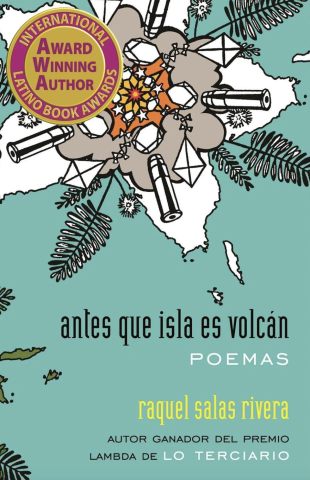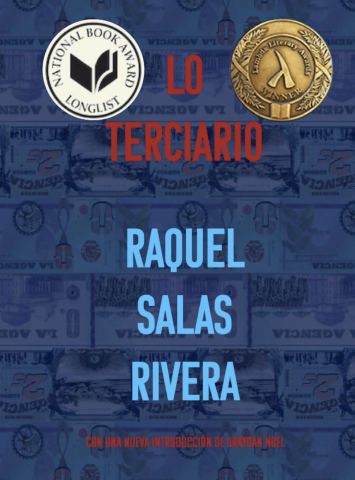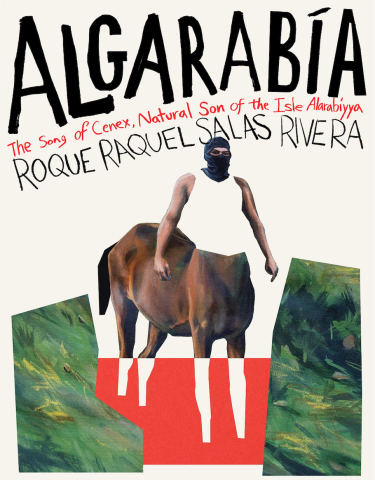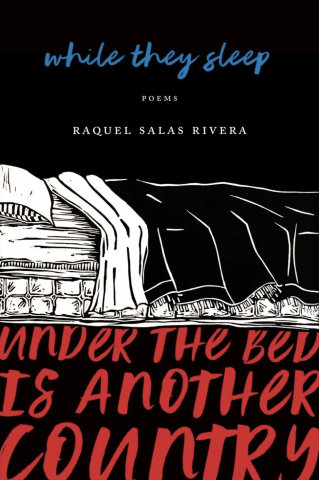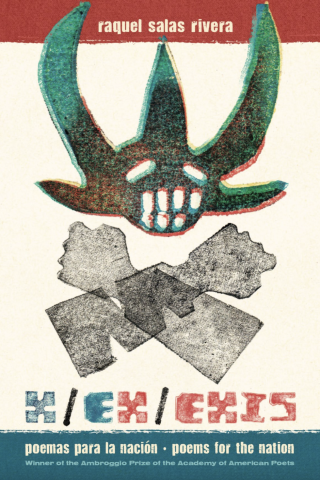sx blog
Our digital space for brief commentary and reflection on cultural, political, and intellectual events. We feature supplementary materials that enhance the content of our multiple platforms.
Meet Our 2026 Editorial Assistants
We are happy to welcome Carlos and J who are joining our team as editorial assistants. And welcome back Dantaé and Laura, our returning assistants. We also thank our outgoing editorial assistant, Luis, for all of his intellectual and organizational contributions to the Small Axe Project.
Incoming Editorial Assistants
Carlos Montes Jiménez is a first-year PhD student in the Department of Anthropology at Columbia University. His research focuses on transnational networks of material and affective solidarity in the Caribbean, and how they articulate political imaginaries beyond the nation-state. Prior to moving to New York City, Carlos received a Fulbright Research Award to conduct research in Belém do Pará, Brazil. He is originally from Añasco, Puerto Rico, and holds a B.A. with distinction in Anthropology from the University of Pennsylvania, where he was a Mellon Mays Fellow. Carlos is passionate about dance, including genres like Brega, Samba de Gafieira, Bachata, and, above all, Salsa.

J Jokhai is a Master’s student at Columbia University in the Department of Anthropology. His research focuses on the relationship between oil and nationalism in Guyana, in the context of the country’s ascendent position in the world-system, its fraught socialist history, and its orientation towards U.S hegemony in the Caribbean. J is interested in political anthropology more broadly, as well as the anthropology of religion, art criticism with an emphasis on Modernist and contemporary art, and Marxism generally. He is honored to serve as a new editorial assistant for Small Axe. When not in class or writing for this journal, he is working to found Extant Magazine: Anthropology, whose first issue hopes to be published the summer of 2026. In his downtime, J is watching MMA, and reading a Manchette thriller on the F train in Queens, where he was born and raised.
Dantaé Garee Elliott, Ph.D., is a visiting lecturer at NYU’s Department of Spanish and Portuguese. Her work focuses on barrels (both as remittances and diasporic practices), the Caribbean diaspora, and contemporary art. Her dissertation, "Barrel Poetics", investigates barrel culture and its creative afterlives across Caribbean visual worlds. She has held diverse roles in academia and the arts, such as Co-Director of the Caribbean Cultural Center African Diaspora Institute Summer Seminar (Curatorial Fellowship class of 2022), Editorial Assistant at Small Axe: A Caribbean Journal of Criticism, and contributor to Forgotten Lands Art, Currents of Africa (Volume 04). She also served as a copy editor for Volume 05, The Haunted Tropics, and translator for Volume 07, Poetics of Architecture. A 2023 Mellon Fellow at NYU’s Hemispheric Institute of Performance and Politics, Elliott co-curated "Coral & Ash", the first solo exhibition of Vincentian photographer Nadia Huggins, at NYU’s KJCC. She was a 2024–2025 Doctoral Fellow at the Center for the Humanities and a Dean’s Dissertation Fellow at NYU, continuing her work at the intersection of Caribbean studies, visual culture, and critical imagination
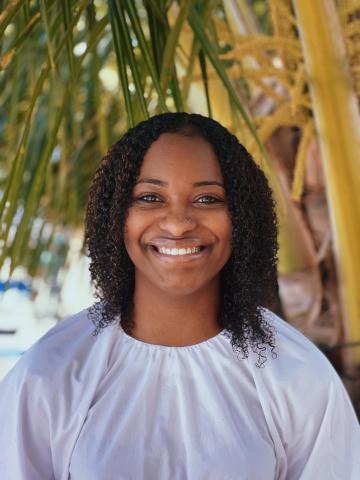
Laura Berríos is a PhD student in the Department of Latin American and Iberian Cultures at Columbia University. Her research focuses on artistic and literary responses to disasters in the Caribbean. She holds a B.A. in Hispanic Studies from the University of Puerto Rico and is a returning Editorial Assistant who enjoys poetry, dancing, and being near the sea.

We thank Luis Frías and wish him the best of luck in his future endeavors.
Luis Frías is a New York-based scholar and writer pursuing a PhD in Latin American, Iberian, and Latino Cultures at the CUNY Graduate Center. Luis’s interests revolve around Mexican literature and cinema, archives, feminism, masculinities, violence, and neoliberalism. He splits his time between parenting his 5-year-old son, Leo, writing his dissertation, teaching Spanish and Portuguese languages, and wrapping up a book of tales. His current obsession is improving his times to run the NYC Marathon.
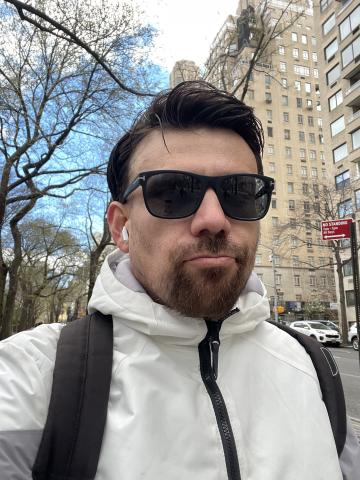
SX 78 is here!
SX 78 is here!
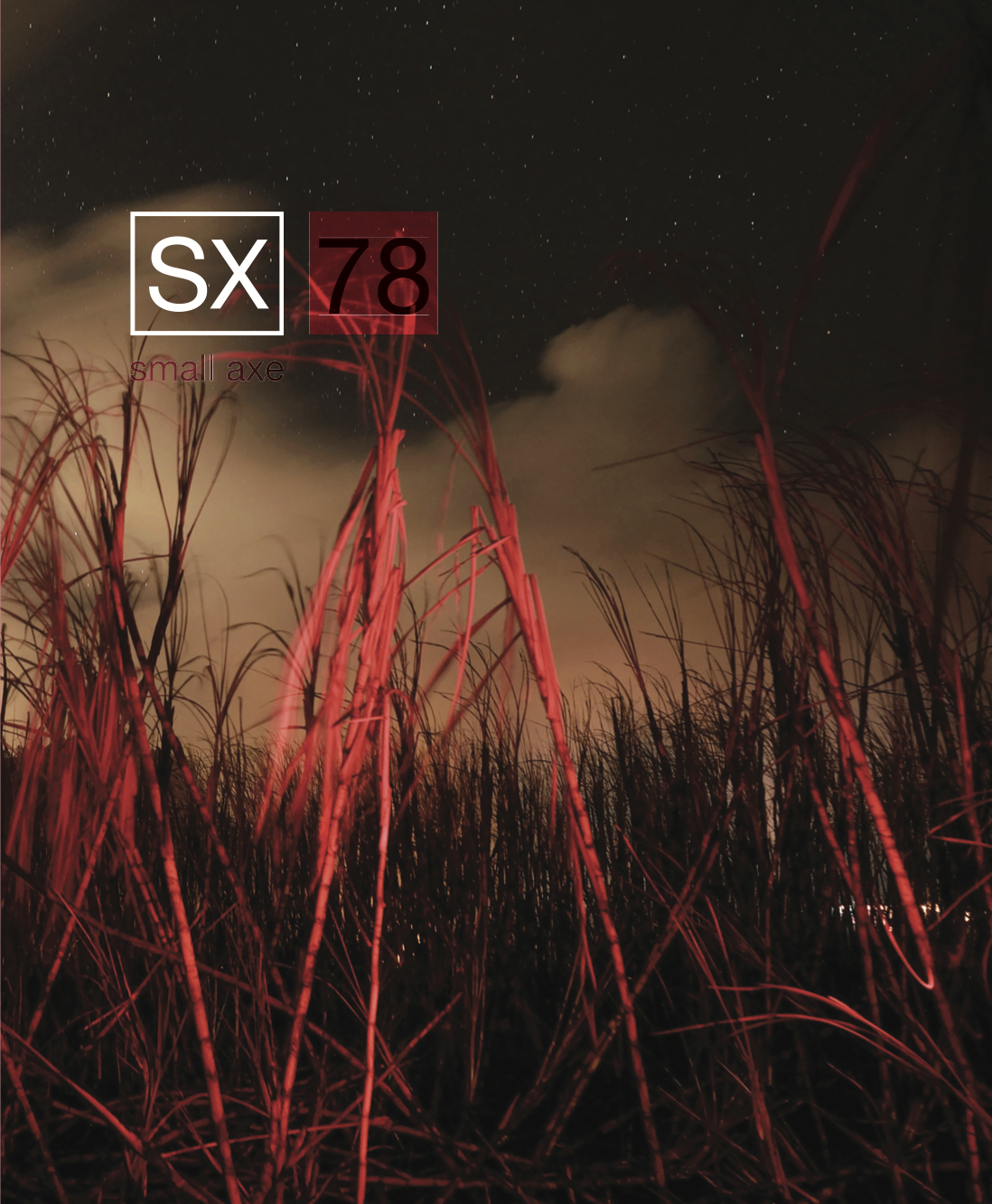
Small Axe 78 includes essays by Florian Gargaillo, John P. Sloan, Rachel Fulford, and Ryan Cecil Jobson. It features the special section "History as Repair: A Forum on Catherine Hall’s Lucky Valley," with essays by Jennifer L. Morgan, Vincent Brown, Robin D. G. Kelley, Walter Johnson, Sasha Turner, Kathleen Wilson, and Catherine Hall. The visualities section features Daniel Goudrouffe's work. Nathan H. Dize writes in the section Translating the Caribbean. The Book Discussion explores Malcom Ferdinand's Une écologie décoloniale: Penser l’écologie depuis le monde caribéen / Decolonial Ecology: Thinking from the Caribbean World, with essays by Alex A. Moulton and Sophie Large.
The Small Axe Project Welcomes Simone Alexander
The Small Axe Project Welcomes Simone Alexander
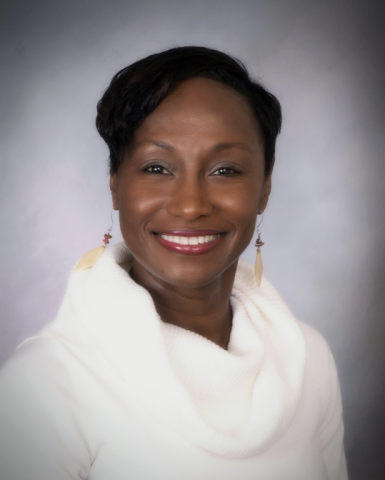
With great pleasure, the Small Axe Project welcomes Simone A. James Alexander to the sx salon editorial team, taking over the role of Book Reviews Editor from Ronald Cummings. Simone is an eminent scholar of Caribbean and Black Diasporic literature with particular attention to the work of women writers; we are so grateful for the erudition, experience and commitment that she brings to this role. Her biography follows:
Simone A. James Alexander is Professor of English and Director of Africana Studies at Lehigh University. Her primary areas of research include women, gender, and sexuality studies; postcolonial literature; transnational feminist theory; Caribbean and migration and diaspora studies. She is the author of the award-winning monograph African Diasporic Women’s Narratives: Politics of Resistance, Survival and Citizenship, which also received Honorable Mention from the African Literature Association’s Book of the Year Scholarship Award. Alexander is also the author of Mother Imagery in the Novels of Afro-Caribbean Women and coeditor of Feminist and Critical Perspectives on Caribbean Mothering. Her scholarship has appeared in numerous journals and edited volumes, including Journal of West Indian Literature, L’Esprit Créateur, African American Review, Wagadu: A Journal of Transnational Women’s and Gender Studies, Turkish Journal of Diaspora Studies, African Literature Today, Anglistica: An Interdisciplinary Journal, and MLA Approaches to Teaching Gaines: The Autobiography of Miss Jane Pittman and Other Work (Modern Language Association). Her current book projects include Bodies of (In)Difference: Intimacy, Desirability and the Politics and “Poetics of Relation” and Black Freedom in (Communist) Russia: Great Expectations, Utopian Visions. She is also the editor of the forthcoming Cambridge Companion to Colson Whitehead. She serves on the editorial boards of Tulsa Studies in Women Literature, SAGE Publications, and Kosmos Publishers (Gender Studies and Equality).
Welcome Roque Raquel Salas Rivera, New sx salon Creative Editor
It is a great pleasure to add our welcome to Roque Raquel Salas Rivera, who joins the Small Axe Project as the incoming sx salon Creative Editor. Roque is a poet of alluring imagery and a translator of distinction, and it is a great privilege and honor to have him in our community in this capacity. Welcome Roque!
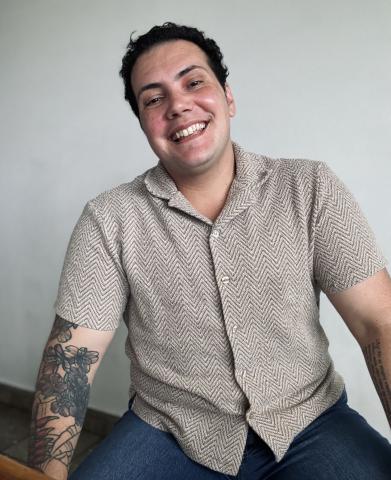
Roque Raquel Salas Rivera is a Puerto Rican poet, educator,and translator of trans experience.His honors include being named Poet Laureate of Philadelphia, the Premio Nuevas Voces, and the inaugural Ambroggio Prize. Among his six poetry books are lo terciario/ the tertiary (Noemi, 2019), longlisted for the National Book Award and winner of the Lambda Literary Award, and while they sleep (under the bed is another country) (Birds LLC, 2019), which inspired the title for no existe un mundo poshuracán at the Whitney Museum. In September 2025, Graywolf Press will publish his epic poem Algarabía. Roque currently teaches in the Comparative Literature Program at the University of Puerto Rico, Mayagüez, and serves the needs of a fierce cat named Pietri.
The Fragile Joy of Staying – If Only in Song: On Bad Bunny’s Residency

My seat neighbors, two best friends clinging to each other, voices breaking and tears streaming as they chanted every lyric of ‘Debí Tirar Más Fotos” (I Should Have Taken More Photos): their friendship louder than the song itself. Photo by the author. All rights reserved.
by Wilfredo José Burgos Matos
For weeks, millions worldwide queued online and in marathon lines for the event of the century: Bad Bunny’s residency at the Coliseo de Puerto Rico. Conceptually, this massive showcase placed Puerto Rico and Puerto Ricanness squarely at the center of global attention, reaffirming national identity and belonging. Simultaneously, it operated as an economic intervention, infusing the island with an influx of tourism, hotel and travel packages, and consumption that has transformed the concert into a temporary but significant driver of cultural and financial capital for locals.
Seeing the global impact it is having and knowing I might never be able to experience something like it again, I attended the tenth concert on Friday, August 1. On the day, I stepped into a sweltering golden San Juan afternoon where the heat clung to the skin and slowed the air. Inside, what unfolded was more than a concert. It was, as many called it, “an experience”: a reckoning with Puerto Rican memory, heartbreak, diaspora mourning, and the pursuit of joy amid gentrification, displacement, and the enduring weight of U.S. colonialism. Bad Bunny’s production traced the pulse of Puerto Rican popular music across time, weaving together tropes that revealed the textures of race, gender, and class identities, until the show itself breathed as a living archive.
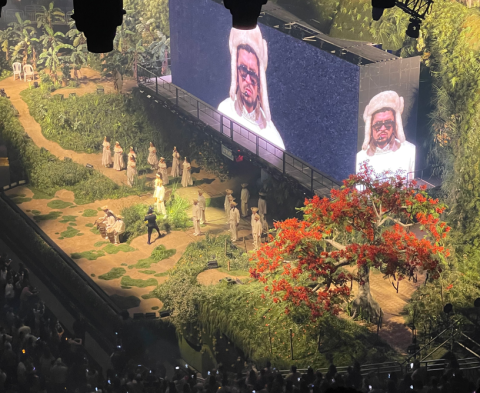
The night opened with percussionist Julito Gastón leading an Afro–Puerto Rican batey de bomba, the communal space where rhythm, dance, and performance converge in Puerto Rican’s oldest musical form. Suddenly, reggaetón crashed into the barriles (bomba drums)in “ALAMBRE PúA” (Barbed Wire). Bad Bunny’s entrance alongside the drums staged a sonic dialogue between bomba and reggaetón, highlighting their intertwined histories.
As Petra Rivera-Rideau argues, reggaetón is rooted in Afro-diasporic traditions, though its Black origins are often obscured to appeal to white and middle-class sensibilities. Bad Bunny’s own racial positioning has sparked debate. Some call him jabao – a Caribbean term referring to light-skinned individuals with discernible African ancestry traits – while others stress his non-Blackness. The opening acknowledged this racial ambiguity. Rather than appropriating Afro–Puerto Rican expression, he staged an encounter, foregrounding entangled genealogies of sound and presenting them as complementary, not oppositional.
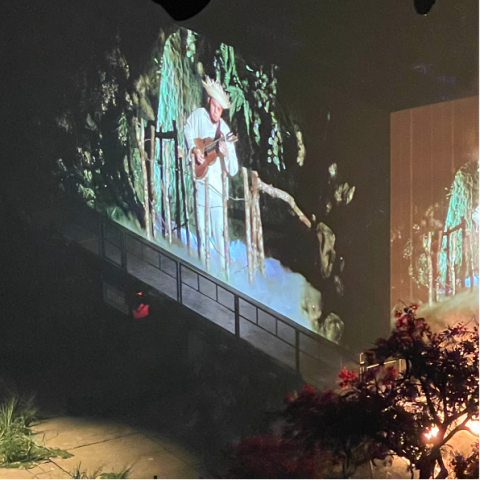
Sonic geographies are central to the residency. From the outset, the concert resisted reducing Puerto Rican Blackness to coastal imaginaries. Still with the barriles resounding, songs like “KETU TeCRÉ,” “EL CLúB,” “LA SANTA,” and “PIToRRO DE COCO” unfolded on a hilltop stage adorned with flamboyanes, plantain trees, a highway billboard, and a Puerto Rican cuatro player, his strings unfurling defiantly into the night. The cuatro, Puerto Rico’s national instrument, is distinguished by its ten paired steel strings and violin-like shape, which produces a bright sonority, historically central to music from the countryside and rural cultural expression.
Sonic geographies are central to the residency. From the outset, the concert resisted reducing Puerto Rican Blackness to coastal imaginaries
This setting repositioned Afro–Puerto Rican cultural life within the island’s interior, unsettling dominant geographies of negritud. The billboard, intruding on the natural landscape, symbolized land exploitation and capitalist encroachment. By blending the cuatro’s timbre with Black aesthetics, Bad Bunny unsettled the notion of música típica as the island’s most “authentic,” non-Black expression, transforming the stage itself into a site of contestation.
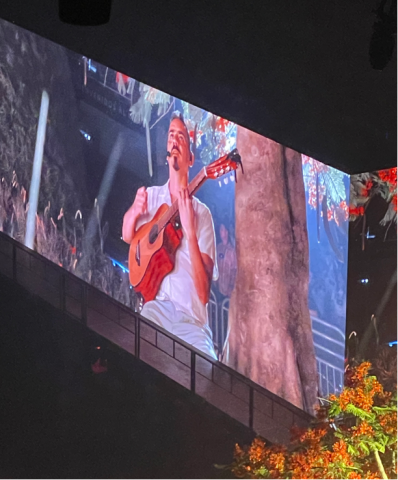
After the rave-like eruption of “El Apagón,” the mood softened. Under a tree with only a guitarist, Bad Bunny sang “VETE” and “TURiSTA.” The sudden quiet peeled away spectacle, evoking intimacy and loss. Reggaetón, often dismissed as pleasure-only, revealed its veins of melancholy and vulnerability.
Bad Bunny spotlighted working- and middle-class urban experiences often erased from glossy island imaginaries. The marquesina became a vital socio-cultural space: a vessel of youth, memory, and diasporic mourning.
The focus then shifted to the now-iconic casita, a secondary stage evoking the party de marquesina (Puerto Rican open air garage parties). Here, perreo nostalgia surged with “Safaera” and “EoO.” By conjuring this rite of passage from adolescence to adulthood, Bad Bunny spotlighted working- and middle-class urban experiences often erased from glossy island imaginaries. The marquesina became a vital socio-cultural space: a vessel of youth, memory, and diasporic mourning. For those abroad, it was a sudden return home. For those on the island, a fragile yet enduring ritual of social life.

Every night, new internationally renowned artists attend the party at the casita. Some of the stars include Ivy Queen, Penélope Cruz, Zuleyka Rivera, Benicio del Toro, and Jon Hamm. On this particular evening, the night’s special guest was Arcángel, who stormed in with “Me Acostumbré,” pulling the show into Latin trap and underscoring Bad Bunny’s versatility and origins. Then Los Pleneros de la Cresta burst into the casita, flooding it with plena, often called the island’s sung newspaper, a popular tradition of working-class expression where social critique, gossip, resistance, and joy circulate through rhythm and verse.
Back on the main stage, “LO QUE LE PASÓ A HAWAii” (What Came to Pass in Hawai’i) mourned an island scarred by colonialism, militarization, and exploitation. The resonance with Puerto Rico was undeniable: two archipelagos commodified, their people sidelined, their sovereignty stolen. Hawai’i’s forced statehood in 1959 resonates directly with Puerto Rico’s unresolved status; two nations bound by shared wounds and the fight for self-determination.
Then came salsa. El Búho Loco, one of the island’s beloved salsa radio voices, narrated the genre’s history before ushering in Los Sobrinos, a young orchestra carrying salsa forward. Their set – “ CALLAÍTA,” “BAILE INoLVIDABLE,” “DtMF (DEBÍ tIRAR MÁS FOTOS),” “LA MuDANZA”– affirmed memory and belonging. During “LA MuDANZA,” the demand that only Puerto Ricans shout “¡Yo soy de P FKN R! (I am from P FKN R)” crystallized the central tension: how to go global without losing the local specificity of Puerto Rican sensibilities.
Over three hours, Benito Antonio Martínez Ocasio delivered a meticulously orchestrated performance that swung between celebratory, defiant, and intimate, always centering the communal. Every beat and image built a sonic and spatial narrative that, while rooted in Puerto Rican experience, resonated worldwide. His curatorial choices underscored his iconhood, his refusal to abandon Puerto Rico, and his call to shield the island from exploitative foreign interests.
Through every genre pivot and spatial cue, Bad Bunny staged a refusal, a reminder that Puerto Rico is not for sale. Even within the contradictions of capitalist spectacle, the desire for sovereignty pulsed through. For three hours, I too believed I would never leave Puerto Rico. I danced, I remembered, I wept. But when the lights came up, I carried with me the aftertaste of diaspora: the endless motion, the grief of always departing, and the fragile joy of staying — if only in song.
Bad Bunny’s residency runs from July 11 through September 14, 2025, spanning 30 concerts. He will then embark on his “Debí Tirar Más Fotos” World Tour, which is set to kick off on November 21, 2025, in Santo Domingo and run through July 22, 2026, spanning Asia, Europe, North America, Oceania, and South America.
Wilfredo José Burgos Matos, Ph.D., is a writer, academic, and performance artist. His book project tentatively titled “Amargue: The Communal Ecologies of a Dominican Feeling,” examines the affective, cultural, and sociohistorical dimensions of Dominican and Dominican-American communal life through the lens of sonic affect and emotional expression. He has published and presented his work in Puerto Rico, the Dominican Republic, Spain, Cuba, Haiti, and the United States. He specializes in Caribbean sounds, music, and affective geographies. Learn more about him at wilfredojose.com.
Squaring the Circle: The Violence of Environmental Form in the Colonial Caribbean
Squaring the Circle: The Violence of Environmental Form in the Colonial Caribbean
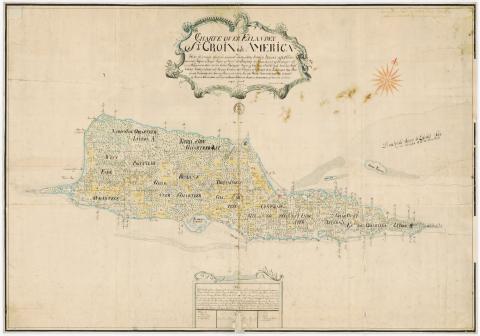
This blog post accompanies the article “Squaring the Circle: The Violence of Environmental Form in the Colonial Caribbean” in Small Axe 77 (July 2025).
by C.C. McKee
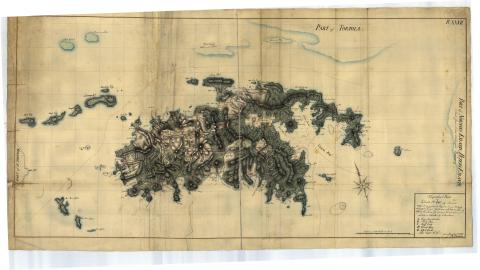
This article begins from the mathematical problem of squaring the circle— using only a compass and straightedge to construct a square with the same area as a given circle—as a method to build upon previous art historical and visual cultural scholarship on the history of slavery and the excessive violence it exercised upon Afro-descended peoples in the Caribbean.
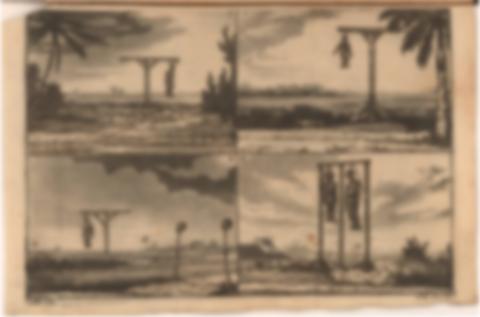
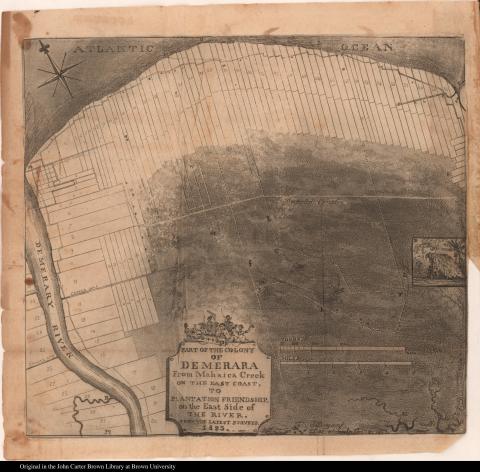
Beyond a reinscription of the racialized body as the ur-site of colonial violence, this essay takes up current debates surrounding formalist method in a range of intersecting fields—film studies, Black theory, visual culture studies, and ecocritical theory—to return to geometric form as a means of locating the pervasiveness of ontological evisceration across scale.
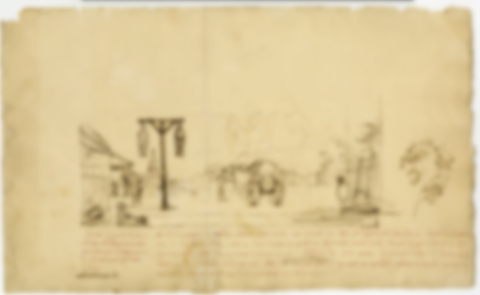
And yet, alongside the hegemonic power structures belied by these circular and rectangular shapes, this essay also locates moments of Black persistence in the Caribbean landscape. I trace this tension between circularity and rectilinearity across the Danish and French Caribbean colonies in the mid- to late-eighteenth century.
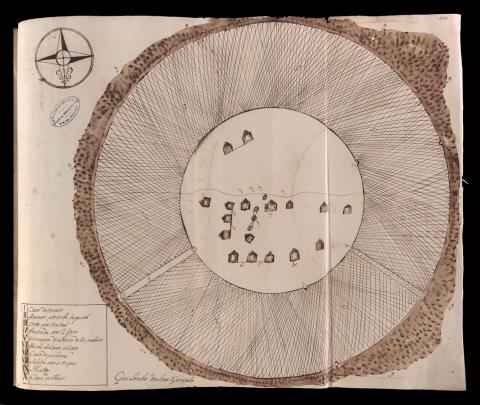
The maps and prints included here are referenced in the printed essay. Because this essay discusses at length images of anti-black violence in the form of execution, I have chosen to reference those images as blurred with a link for readers to see the original.
Dialogues in Caribbean Modernism: A Small Axe Symposium
Dialogues in Caribbean Modernism: A Small Axe Symposium
Artists, scholars, writers, and art practitioners gathered at the University of Puerto Rico, Río Piedras, on 24 and 25 October for the second iteration of the Small Axe Caribbean Modernisms project. The symposium challenged the Western formation of modernism as an artistic style and its effect on a set of artistic and intellectual practices in the Caribbean and its diasporas to make a case for “Caribbean modernism.”
By Dantaé Elliot
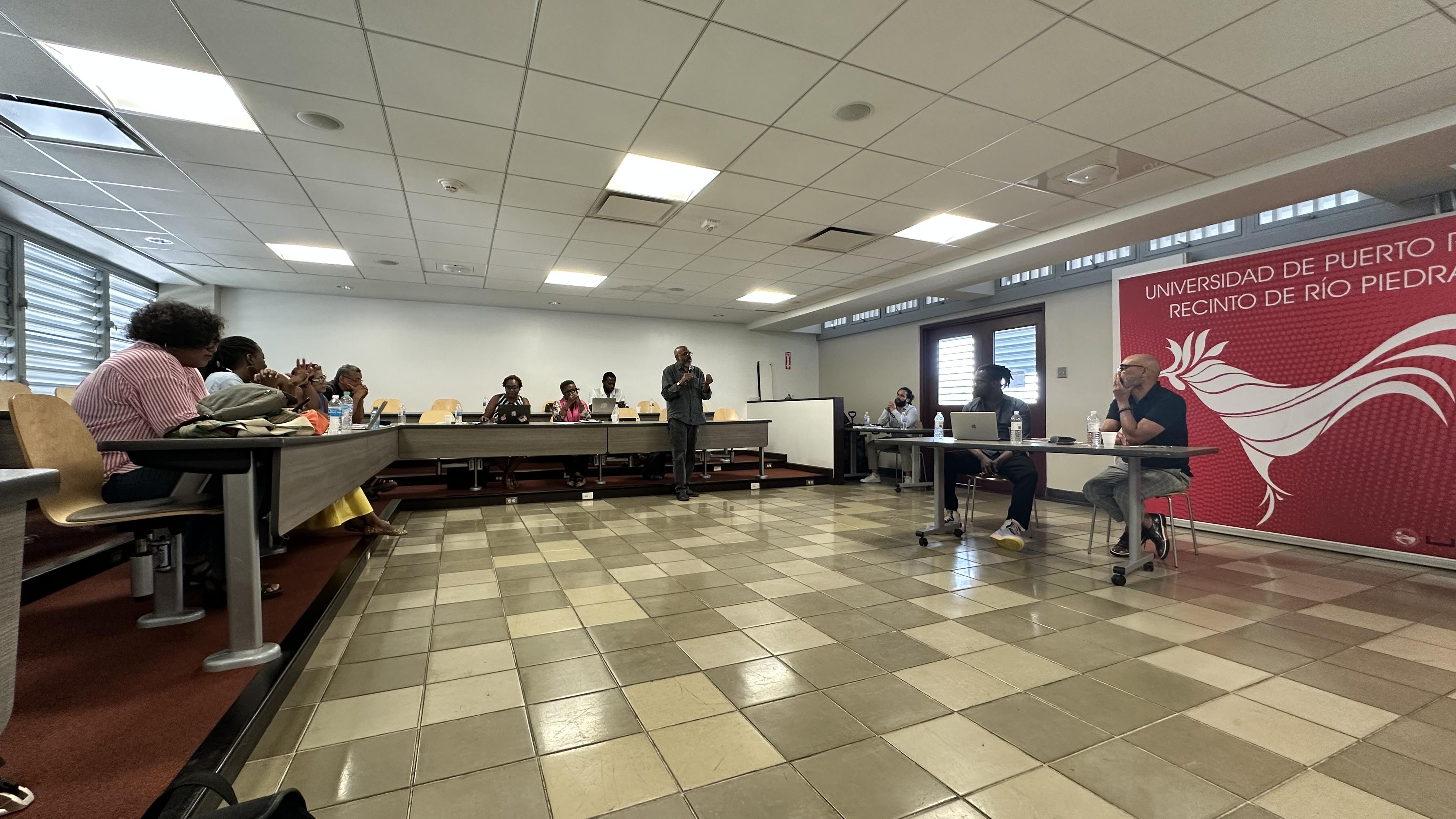
The first Caribbean Modernisms Symposium was held in Amsterdam, NL from 9 to 11 November 2023, and explored the questions, what and when was Caribbean modernism? The recordings and papers generated during that symposium are now available on our website.
The most recent symposium was organized around intergenerational, interisland, and interdisciplinary conversations to explore the forces that shape contemporary Caribbean literature, art, and discourses about injustice and struggles against it. Presenters from Puerto Rico, Haiti, Jamaica, Suriname, Curaçao, and the diaspora dialogued with each other about the emergence of new aesthetic styles and cultural-political languages developed by Caribbean writers and artist that respond to modernism similarly but with crucial differences that consider memory, time, space, and locality.
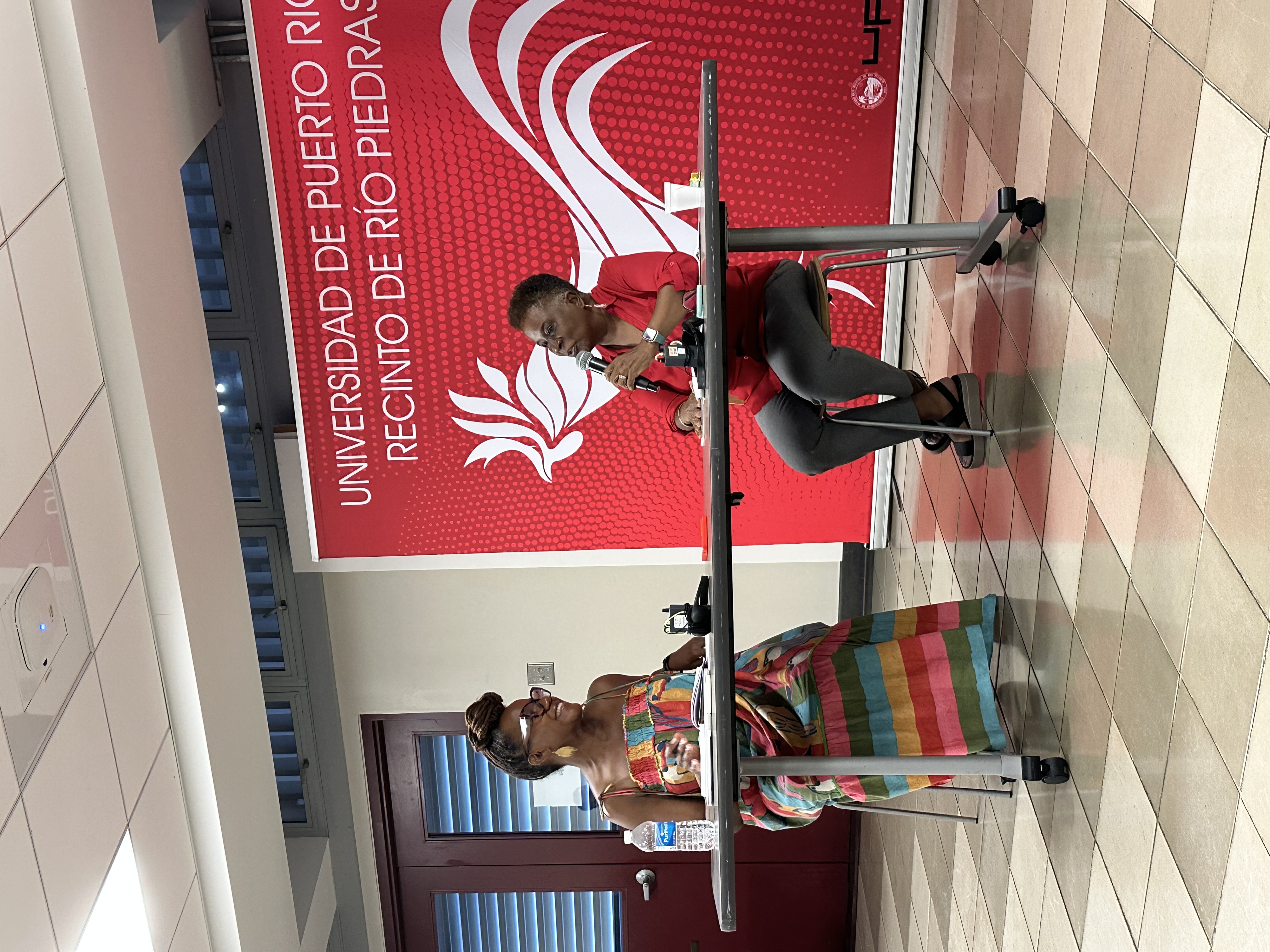
Évelyne Trouillot and Régine Jean-Charles 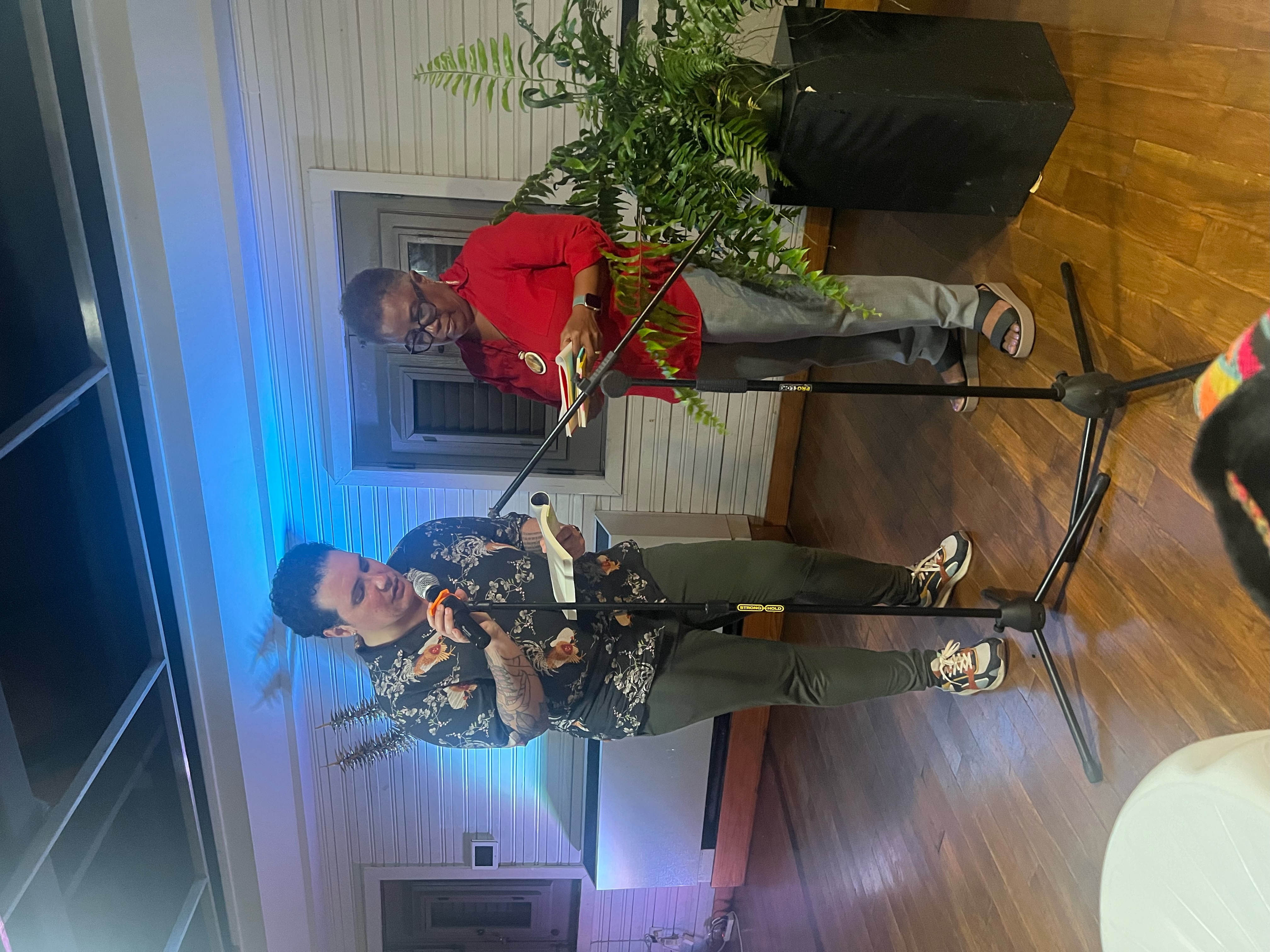
Roque Raquel Salas Rivera and Évelyne Trouillot at Casa de Cultura Ruth, Poetry evening 
Mayra Santos-Febres at Casa de Cultura Ruth, Poetry evening
The conversations spoke to the malleability of the diasporic Caribbean and the region, which blends linguistic and visual elements (Caribbean Creole, French, Spanish, English, Haitian Kreyòl, and Dutch) as points of intersections for discussing Caribbean modernism as a process rather than a specific time and place.
The symposium concluded with a roundtable of invited artists and curators at Museo de Arte Contemporáneo on 26 October. The conversation addressed some challenges art institutions face in the Caribbean and the complexities of producing intra-regional exhibitions, precisely highlighting Puerto Rico as a colony/territory. In this regional dialogue, artists and art practitioners in Puerto Rico imagined ways to materialize more collaborative projects through different Caribbean art institutions.
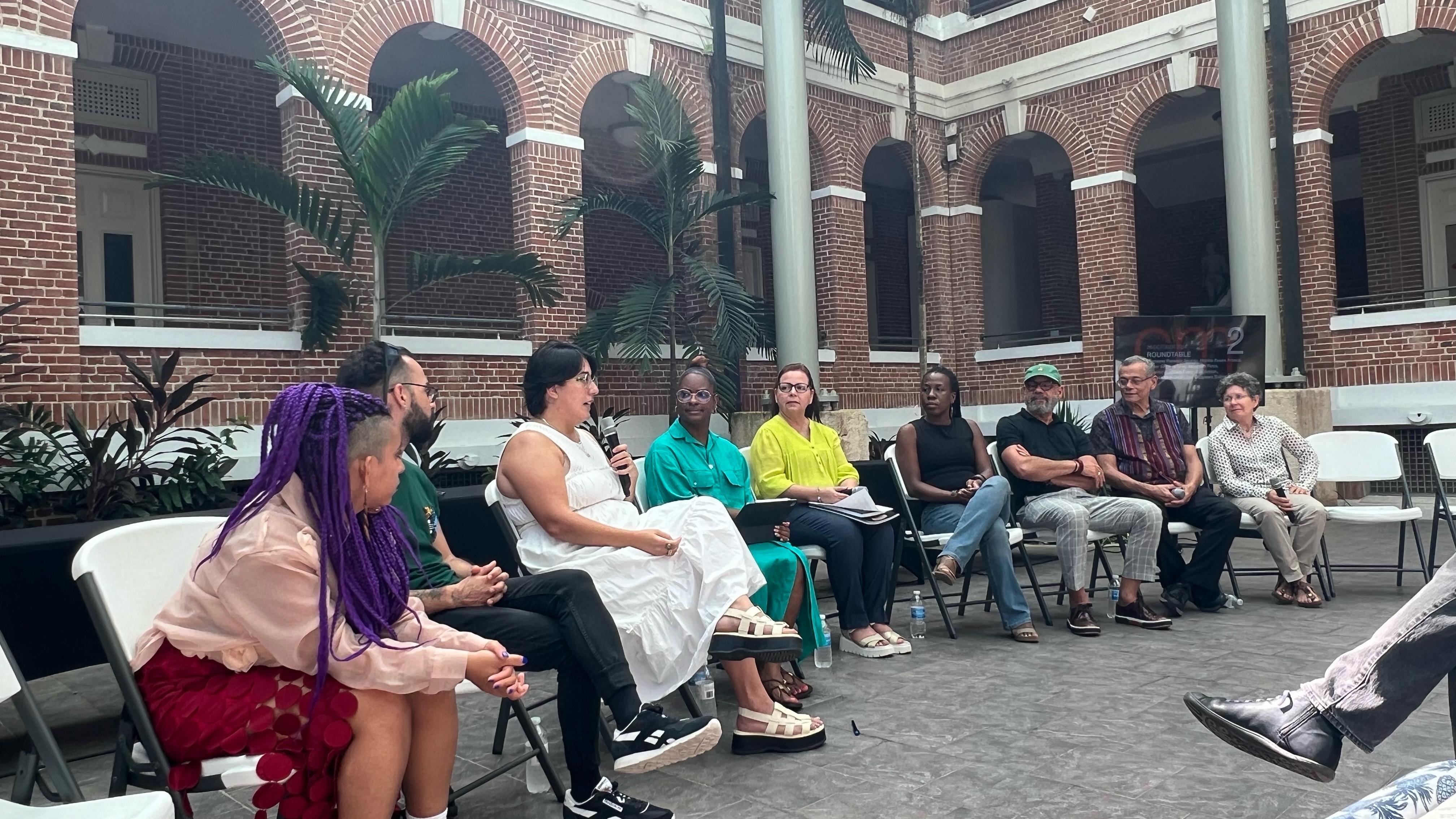
Dialogues in Caribbean Modernisms made space for the participants to wrestle with the inconsistencies and limitations of modernity by considering the transnational and multilingual position of the Caribbean and its refusal of a category and creating alternative forms of knowledge, be it ancestral, Indigenous, environmental, or community-based.
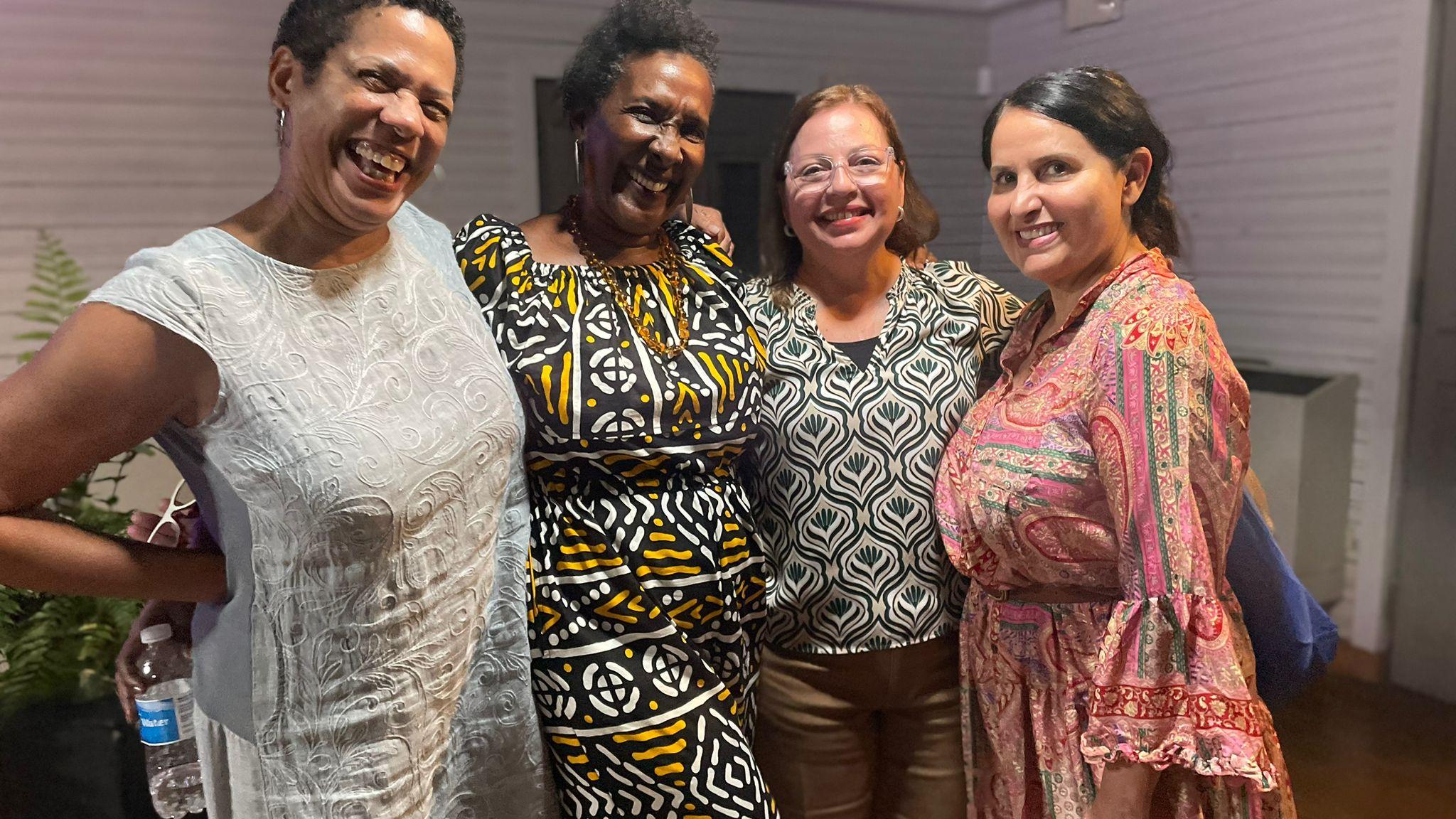
You can learn more about Dialogues in Caribbean Modernisms by visiting our website.
Meet the Small Axe 2024 - 2025 Editorial Assistants
We are happy to welcome Laura, Caprie, and Luis who are joining our team as editorial assistants. And welcome back Dantaé, a returning assistant. We also thank our outgoing editorial assistants for all of their intellectual and organizational contributions to the Small Axe Project.
Meet our incoming Editorial Assistants:
Laura Berríos is a PhD student in the Department of Latin American and Iberian Cultures at Columbia University. Her research examines representations of violence and narcoculture in contemporary literature and popular music from the Spanish-speaking Caribbean. She holds a B.A. in Hispanic Studies from the University of Puerto Rico. As an undergraduate, Laura was a Mellon Mays Fellow and worked as a youth tutor with the community-based initiave Huerto, Vivero y Bosque Urbano de Capetillo in Río Piedras.
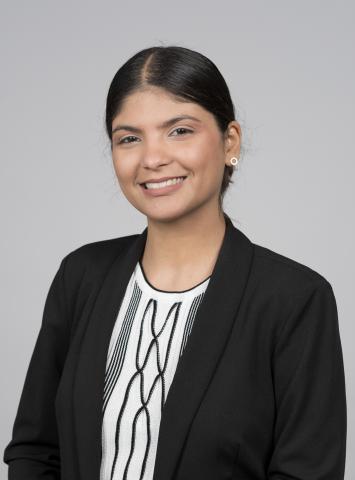
Luis Frías is a New York-based scholar and writer pursuing a PhD in Latin American, Iberian, and Latino Cultures at the CUNY Graduate Center. Luis’s interests revolve around Mexican literature and cinema, archives, feminism, masculinities, violence, and neoliberalism. He splits his time between parenting his 4-year-old son, Leo, writing his dissertation, teaching Spanish and Portuguese languages, and wrapping up a book of tales. His current obsession is improving his times to run the 2025 NYC Marathon.

Caprie Hughley is a student at Queens College earning my bachelor’s degree in English. Reading and writing are two things she enjoys doing. Which is why she loves creating content on authors, books, and my opinions of the books I read. "Having a platform to help up in coming writers is needed and is why I create the content," she says. "Becoming a part of the Small Axe team is an honor and I am excited about what this semester has in store for me."
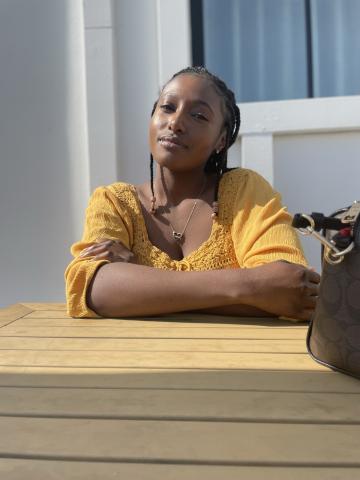
Dantaé Elliott is a PhD Candidate in the Department of Spanish and Portuguese at New York University. She has a particular interest in contemporary Caribbean Art and its relation to migration within the Caribbean diaspora and region, while examining the phenomenon “barrel children syndrome.” She is a featured artist in Volume 4 of Forgotten Lands, titled Currents of Africa, released in June 2022. Dantaé is a returning editorial assistant.

Thanks to our outgoing Editorial Assistants:
Tyler Grand Pre is a PhD candidate in the Department of English and Comparative Literature and ICLS affiliate at Columbia University. His research revolves around poetic responses to the infrastructure of race—that is, the networks of technologies, materials, and, as he argues, representational practices that structure the social, economic and spatial hierarchies of race. Tyler examines the way different writers and artists respond to the built and mapped environment to reimagine community both within and without the borders of language, race, and geography.
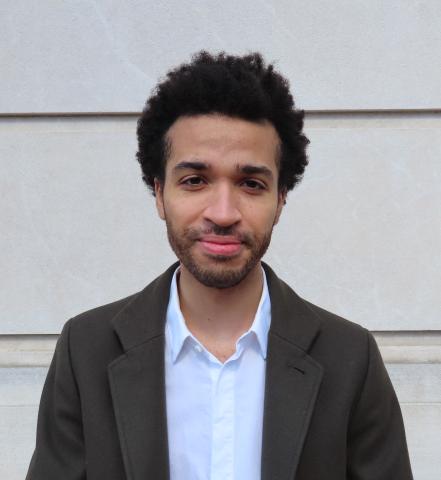
Mayaki Kimba is a PhD student in the Department of Political Science at Columbia University, specializing in political theory. His research interests concern the legacy of empire in shaping ideas around race and migration in twentieth-century Western Europe. Other and related interests include Black political thought, anticolonial political thought, (social) citizenship and the welfare state. He was born and raised in the Netherlands, and graduated with a B.A. in political science from Reed College in May 2020. His essay on T. H. Marshall, late imperial ideology and racialized migrant exclusion was selected for a 2020 award by the Undergraduate Essay Prize Committee of the North American Conference on British Studies.
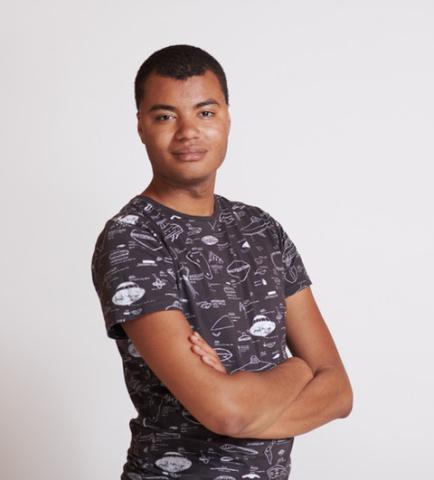
SX 74 is here!
SX 74 is here!

Small Axe 74 includes essays by Fatoumata Seck, Mary Grace Albanese, and Mónica B. Ocasio Vega. The special section on "The Cultural Poetics of Carolyn Cooper" features work by Nadi Edwards, Louis Chude-Sokei, Nadia Ellis, Ananya Jahanara Kabir, Njelle Hamilton, and Carolyn Cooper. In this issue we publish the third iteration of our Keywords project with an exploration into the critical terms used to theorize Caribbean sexualities with essays by Lawrence La Fountain-Stokes, Wigbertson Julian Isenia, Krystal Ghysyawan, and Jacqueline Couti. The cover and visualities essay "Buss head Hard head," showcases the art of Natalie Wood. Rocío Zambrana's book Colonial Debts: The Case of Puerto Rico is discussed by Judith Rodriguez, Ernesto Blanes-Martinez, and Agustin Lao-Montes.
An Archive in Memories: Remembering Joyce Moore Turner
Mayaki Kimba
An Archive in Memories: Remembering Joyce Moore Turner
Mayaki Kimba
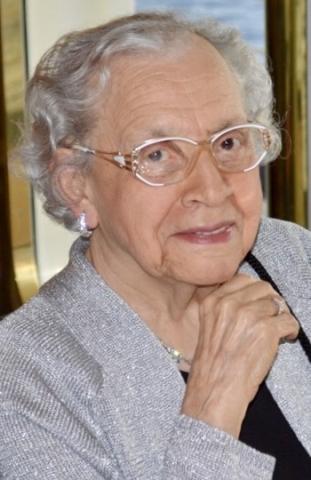
In Memoriam
Joyce Webster Moore Turner (1920–2024)
When I think of an archive, I tend to think of documents, files, folders, boxes, catalogs, and in a more significant sense, the past, which scholars reconstruct as they try to cobble together a coherent picture from a set of disparate documents.
Headaches also come to mind when thinking of archives. There are undated documents, documents without a listed author, and documents that are barely legible. Every archive understandably has its own rules, and many archives operate under financial strain, giving them no choice but to limit access hours.
Only very recently, I have gained a very different association with archives. That is, in studying the archive of the Caribbean radical Hermina “Hermie” Huiswoud (1905–1998), I have come to appreciate that archives are about relationships.
Such relationships can and often have been extractive and exploitative, as is the case with most if not nearly all colonial archives. Sometimes, however, archives are kept, maintained and guarded with love, care, and friendship in a way that can and should be humbling to academics—like yours truly—whose first instinct in visiting an archive is to glean information suitable for publication, as opposed to assessing what it would mean to do right by the people to whom the documents in question originally belonged.
I appreciated this lesson most fully when I visited Joyce Moore Turner on May 5, 2024. Turner spent her life as a nutritionist, assistant principal, and teacher. She worked to establish neighborhood health centers in Suffolk County, New York, and was a founding member of the Unitarian Universalist Fellowship of Bellport, as well as the Brookhaven Branch of the NAACP. Her father, Richard B. Moore (1893–1978), had been part and parcel of the Harlem Renaissance, and a key organizer of the Communist Party in the United States. Together with her late husband, W. Burghardt Turner (1915–2009), Joyce Moore Turner wrote a biography of Moore and published his collected writings in Richard B. Moore: Caribbean Militant in Harlem. Turner also authored articles on Unitarian minister Rev. E. Ethelred Brown, as well as the book Caribbean Crusaders in the Harlem Renaissance. This latter publication told the story of the aforementioned Hermina Huiswoud, and that of her husband, Otto Huiswoud (1893–1961).
My visit to Turner was occasioned by the Huiswouds, to whom the upcoming issue of Small Axe dedicates a special section. The Huiswouds were both from the Guyanas: he hailed from Suriname and she did from then-British Guyana. Based for various periods in Harlem, Moscow, Paris, and Amsterdam, the organizing efforts of the Huiswouds took them up and down the Caribbean, the continental United States, and beyond.
David Scott proposed publishing a special section on these understudied radicals back in September 2022. This project got well underway, with Small Axe organizing a symposium on the Huiswouds from September 8–9, 2023 in Amsterdam, in collaboration with the Tropenmuseum, the International Institute of Social History, and The Black Archives.
Originally, I was supposed to only write a short introductory piece for this special section. I thought this would be a good idea, as I am a doctoral student, and the Huiswouds are not directly related to my dissertation topic. Alas, I got carried away, and the short introductory text turned into an essay, not in the least because I read archival documents showing the Huiswouds to harbor political and intellectual vistas that stretched far beyond the doctrinarian Stalinism with which the Huiswouds have often been equated.
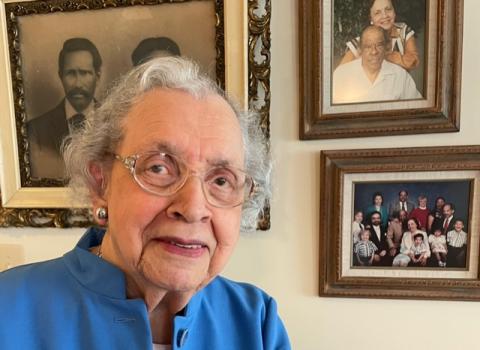
As I was seeking practical information about archival documents I had found at the Tamiment Library and Robert F. Wagner Labor Archives of New York University, I got in touch with Polly Levens, who had deposited archival materials of the Huiswouds at the International Institute of Social History in Amsterdam. Levens was incredibly responsive and helped me reach Turner, who deposited the documents archived at NYU. In all of this, my intuition was to make sure that my requests for information were not imposing on Turner’s time, but as I would quickly learn, I need not have worried.
As I soon learned from her daughter Sylvia, Turner had been waiting for years for scholarly engagement with Hermina Huiswoud—or Hermie, as everyone called her and as she called herself in all but the most formal of occasions.
Turner first met Hermie when Turner was still a “tot,” only four years old. They reconnected decades later, when Turner was doing research for the book on her father, Richard B. Moore. Turner was hoping to speak to Hermie about him, as Moore had been a friend of the Huiswouds, and a fellow member of the Communist Party. An initial meeting in 1983 developed into a long and warm friendship, with Turner flying to Amsterdam each year in order to catch up with Hermie. In between visits there was voluminous letter writing.
Hermie was dissatisfied with how historians had written about her husband, who passed away in 1961. She sought to set the record straight by writing a biography of Otto. In light of her own health struggles, she welcomed the help of Turner, to whom she gave her papers. In sum, what begun as an effort by Turner to gain more information about her father resulted in a long-lasting friendship and a new book project, which came to fruition with the publication of Caribbean Crusaders in 2005.
Given her friendship with Hermie, Turner went above and beyond in helping me with my essay on the Huiswouds, including searching for and reviewing the many letters that Hermie sent her. At the same time, she was also protective of Hermie and wanted to know what, exactly, my project entailed. She thus encouraged me to visit her in person.
When I finally got the chance to make the trip from New York to Maryland to visit Turner at her retirement home, we were able to talk for multiple hours with only a few breaks in-between, not only thanks to the tireless efforts of her daughter Sylvia to facilitate the conversation, but also thanks to the self-evident determination of Turner to do right by her friend. The dining table was covered in documents that family members had recovered from dozens of storage boxes.
Turner recalled memories about everything from her own youth to her relationship with Hermie and the process of writing and publishing Caribbean Crusaders. She also showed herself as still very much an independent thinker who was not afraid to push back if she did not agree with where I was headed. For instance, I was making much of an unpublished play penned by Hermie, but Turner helped me see that it was not overall the most representative text of Hermie’s oeuvre.
“My writings have never been because I thought I was a writer,” [...] Instead, she felt her “job was to bring knowledge that [she] had to help the other people who were real historians.”
It was here that it dawned on me that relationships to archives need not just be governed by those of academics.That is, Turner did not just want to avoid me overstating the importance of one text, she also wanted to do right by someone whom I knew things about, but whom she knew.
Turner, to be sure, was herself highly familiar with the norms and practices of academics—her late husband was a historian and so is Franklin Knight, a dear family friend.
Turner nonetheless resisted applying to herself the label “historian” and even that of “writer.” “My writings have never been because I thought I was a writer,” she told me. Instead, she felt her “job was to bring knowledge that [she] had to help the other people who were real historians.” In her view, she “just had some information and [she] wanted to share it so that it could work its way into some of the stories that are not correct.”
Even as Turner sought to correct mistakes, she strove to keep her distance from historiographical strife. She “would’ve been very uncomfortable,” she said to me, to just be “fussing with the historians who didn’t write like [she] thought they should.” It is not so much that Turner was against those historiographical debates, but that she felt that she did not belong in them. Indeed, on making historiographical interventions, she said: “we have people who can do that and do it well, but I am not one of those. I’m one who just brings you food crumbs [so] that you can then put pieces together a little differently, because you just didn’t know what I know at this moment.”
There is something refreshingly non-disciplinarian about this approach, even as the approach is rigorous in its own way, seeking as it does to undo misunderstandings, misinterpretations, and misattributions. Of course, correcting such errors is part and parcel of what historians do as well, but they often position archival evidence as the (only) standard for establishing factual truths. The problem is that archival evidence often falls short in accounting for the kinds of lives that Otto and Hermie led.
The limits of the archive are well-known and well-debated, not least in the pages of Small Axe. Such debates on the archive typically concern people who were enslaved or otherwise oppressed and rendered faceless and nameless in the written record. Otto and Hermie do not quite fit in this category, as they did make their way into the written archival record. They both wrote articles for newspapers and magazines, publications like the Daily Worker enthusiastically reported on Otto’s whereabouts, and there are still people around, of whom Turner was one, who knew Otto and especially Hermie personally. What is more, between the 1920s and early 1950s, the FBI spilled much ink on them. Indeed, archival FBI documents obtained through a FOIA request show that the agency had intercepted multiple personal letters that the Huiswouds had sent to each other.
This presence of surveillance also clarifies the persisting difficulties in accessing archival documents on the Huiswouds. They knew they were being surveilled and acted accordingly.
Otto probably would have considered it an achievement that so few of his personal documents ended up surviving, and Hermie too was always on guard to defeat any surveillance operatives. Even with Turner, she refused to talk about her radical past inside her apartment, insisting that she and Turner talk outdoors. Hermie furthermore would not allow Turner to make handwritten notes on their conversations. Indeed, Turner remembered Hermie telling her to just “listen and remember.” The Huiswouds thus worked quite diligently and successfully to produce, with good reason, an archival silence about themselves.
The archival silences affecting the Huiswouds necessitate a reemphasis on the spoken, as opposed to the written word. And in this case the spoken word is truly such because while it is not uncommon for scholars to engage oral testimony, transcribing such testimony is usually the self-evident first step in integrating oral testimony into historical writing. Yet in the case of Hermie, her refusal to use or allow recording devices or even notetaking by hand imply that some parts of her and Otto’s life can be relayed only through memories of what Hermie chose to share.
To be sure, for Turner, relying on what Hermie shared with her did not mean disregarding archival sources. Caribbean Crusaders is full of citations to archival materials. Yet the way in which Turner interpreted those materials did change thanks to her friendship with Hermie and her access to what Hermie only wanted to share in unrecorded conversations.
One way in which this different interpretation comes through is in the overall framing of Caribbean Crusaders, which positions the trajectory of Otto and Hermie in the context of the Harlem Renaissance. This context was crucial for Turner, and in our conversation, Turner confirmed that she herself “was never a communist. That wasn’t what [brought Turner] to this. It is the Harlem Renaissance.”
In using the Harlem Renaissance as a frame for the lives of Otto and Hermie, Turner pushed the limits of the periodization of the Harlem Renaissance, which typically does not extend beyond the mid-1930s. Yet the frame of the Harlem Renaissance allows an appreciation of the legacy that it left and the self-regard that it imprinted on those who were part and parcel of the movement.
Indeed, the archival collection of Hermie Huiswoud at the Tamiment Library includes an English translation by her of an obituary of Otto that appeared in De Ware Tijd (“The True Times”), a Dutch-language Surinamese newspaper. Hermie added an annotation to her translation, which specified that the poems read at her husband’s funeral were “The Negro” (1922) by Langston Hughes and “The New Negro” (1927) by James Edward McCall. This latter poem, Hermie added, “depicts” her husband “completely.”
It feels significant that in looking back at her late husband’s life, Hermie found not some proletarian poem but a quintessential Harlem Renaissance poem the encapsulation of what her husband represented.
To be sure, none of this is to downplay the continued commitment of Hermie to the Communist cause, which Turner stressed to me in our conversation. It is rather that there were more aspects to the lives of Otto and Hermie than those of international Communism.
∗ ∗ ∗
It is not just with the Huiswouds that Turner was able to use her personal knowledge of her subjects of inquiry to cast a different light on what the archive suggested. Indeed, her two other writings are about people she knew very well: her father Richard B. Moore and Rev. E. Ethelred Brown.
In her essay on Brown, a pioneering Black Unitarian minister who founded the Harlem Community Church in 1920, Turner discussed that she had not been aware of the acrimony between Brown and the American Unitarian Association (AUA) until she “conducted research at the AUA archives in Boston.” Yet rather than conclusive archival evidence that provided the truth of the relationship between Brown and the AUA, the written record in the archive distorted who Brown was. Turner accordingly wrote:
"Those documents [at the AUA archives] were compelling in portraying Brown as a tragic figure struggling to carry out his mission as an Apostle of Unitarianism. They presented him through a limited and limiting lens which failed to reveal his vision, wide interests and contributions to the communities in which he initiated his ministry. It required considerable study to discern that Brown did not see his rejection by the authorities as the focus of his mission but as a personal, private, formidable hurdle he had to overcome in order to pursue his mission."
It is sobering to read of this disconnect between how archival documents present Brown and how Brown is remembered by people like Turner who held the Harlem Community Church as a part of their “earliest memories.” Archival documents, then, cannot speak for themselves.
In the case of Turner’s father, too, the exercise of reconstructing his life came with challenges—as reflected in the motivation of her original visit to Hermie in the early 1980s. And while Richard B. Moore produced enough writings to fill the book that Turner coedited with her late husband, none of Moore’s writings provide a comprehensive biography. As Joyce Moore Turner related to me: “Even though my father had been pushed by a lot of people to write about himself, he never did. Really. And that’s true for a lot of people.”
Moore and indeed many other radicals did not write their autobiography. Nonetheless, their political writings do allow for an intellectual biography of sorts, and they also offer a window into how intellectuals and political activists in the past understood their political present.
For Moore, this political present was marked by the end of empire. Turner accordingly encouraged me to read carefully his 1965 article titled “The Passing of Churchill and Empire.” In this article, Moore called Churchill “the last of the great statesmen of empire of our era.” The actions of Churchill during World War II had to be understood as well, Moore insisted, in an imperial context. For Moore, Churchill’s vociferous opposition to Hitler could be explained by “the agreement at that specific moment and in that particular conjuncture of events, of the vital interests of the British Empire with those of the great overwhelming majority of mankind.” Moore thus asserted the centrality of empire to not just the history of (former) colonies but to that of Europe itself.
For Moore, the death of Churchill meant that “the system of empire which [Churchill] served so well moves irrevocably into the limbo of the past.” In attaching the end of empire to the death of one person, Moore expressed his appreciation of leadership and its importance in driving political change. Churchill, for Moore, “exemplified and exercised, on behalf of his power group, certain great talents and valuable qualities.” Such qualities, Moore added, “are also requisite for the oppressed peoples and groups, if their complete liberation is to be assured.”
In writing of oppressed people’s need for leadership, it is likely Moore was thinking about the West Indies Federation. One year earlier, in an article for the Summer 1964 issue of the publication Freedomways, he had reached the following conclusion about the failure of the Federation:
"Those of us who by enforced economic exile, or through some enlightening experience, have managed to overcome narrow insularity, petty provincialism, purblind prejudice, and smug satisfaction, ought to exercise care lest we stir the ever smouldering embers of disastrous discord. This, then, is hardly the time to identify personalities responsible for the miserable, petty demagogy, strange intellectual weakness, cupidity, insularity, and titled ineptitude, unexplained insistence upon unitary association as yet unrealized, self-centered leadership and opportunist opposition, which even now hinders the fruition of a genuine East Caribbean Federation as a step forward. Let us now simply say that all the chief Caribbean political leaders of that period together bear responsibility, in varying degrees, for the miserable debacle and the distressing setback of the Caribbean liberation movement."
While it can be hard to capture in print the legendary reputation of Moore as an orator, this passage succeeds in conveying the tremendous felicity that Moore had with language, which he used in this case to convey emotional disappointment as well as analysis. Leadership mattered, he vividly argued, and when it had mattered most, Caribbean leaders fell short. “Favorable conditions do not automatically produce change,” Moore insisted, as one needed “a conscious, devoted and able leadership … to take advantage of favorable conditions.”
On the one hand, the focus on leaders is dispiriting because it suggests that a fruitful historical opportunity was squandered due to self-interested and incompetent leaders who could not bring to the anticolonial cause what Churchill had brought to the imperialist cause. On the other hand, the focus on leaders preserves the idea that change is possible if only one finds a leader who is capable. It suggests that not everything is set in stone, and that opportunities do arise and that one can make use of them to secure a different future.
The aforementioned McCall poem—in which Hermie recognized her late husband—speaks of a New Negro who “foresees new empires rise and old ones fall.” In declaring that this New Negro holds “his destiny within his hands,” the poem gestures toward a regained sense of autonomy, as well as that of a changing world.
In the present, perhaps, the sense of a changing world is no longer there. In rereading the aforementioned passage in which Moore excoriates Caribbean political leaders, I found it hard not to notice the resonances with what David Scott described in Conscripts of Modernity as a “postcolonial nightmare” characterized by “the acute paralysis of will and sheer vacancy of imagination, the rampant corruption and vicious authoritarianism, the instrumental self-interest and showy congratulation [that] are all themselves symptoms of a more profound predicament that has, at least in part, to do with the anxiety of exhaustion.”
Was Moore in 1964 sensing the contours of a nightmare that still envelops the postcolonial present, a nightmare that has exhausted the political projects that Moore and the Huiswouds pursued during the Harlem Renaissance? Knowing the answer to that question requires knowing what those political projects were in the first place. And one lesson from speaking with Turner is that to attain even that modest goal, much work still lies ahead.
∗ ∗ ∗
Turner passed away in peace on August 27, 2024. It is a testament to how extraordinary a person she was that so much of what I was able to write above is based on just one meeting with her. And given her own efforts to do right by Hermie, it is only right that we do right by her and celebrate the lasting and indispensable contribution that she has made in society and in the field of Caribbean Studies.
Interviewer bio
Mayaki Kimba is a political theorist and historian of political thought, interested in questions of the state and freedom, liberalism and empire, and Black and anticolonial political thought, especially from Suriname and the Dutch Caribbean. He is a Ph.D. candidate at Columbia University, and his dissertation concerns how state practices in the intimate sphere affected varying perspectives on the state among Black migrants in 1970s Britain, France, and the Netherlands.
